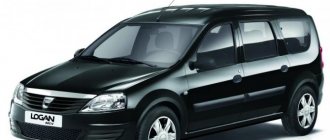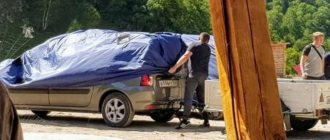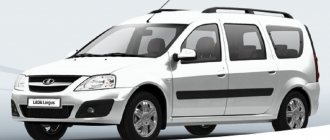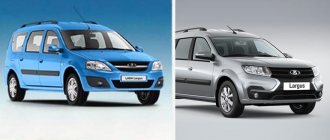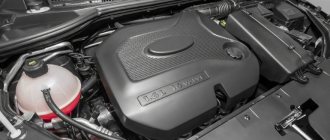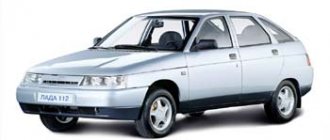| LADA Largus | |
| Total information | |
| Manufacturer | AvtoVAZ |
| Years of production | 2012 - present |
| Assembly | AvtoVAZ (Tolyatti, Russia) |
| Class | Compact |
| Other designations | Dacia Logan MCV Renault Logan MCV |
| Design | |
| Body type | 5-door station wagon (5-seater) 5-door van (2-seater) |
| Platform | B0 |
| Layout | front engine, front wheel drive |
| Wheel formula | 4 × 2 |
| Engine | |
| K7M | |
| Manufacturer | Renault |
| Type | petrol |
| Volume | 1598 cm 3 |
| Maximum power | 60 kW (82 hp), at 5500 rpm |
| Maximum torque | 124 Nm, at 3000 rpm |
| Configuration | in-line, 4-cylinder. |
| Cylinders | 4 |
| Valves | 8 |
| Max. speed | 156 |
| Acceleration to 100 km/h | 14,5 |
| Combined fuel consumption | 9,3 |
| Fuel consumption in the urban cycle | 12,3 |
| Fuel consumption on the highway | 7,5 |
| Environmental standards | Euro 4 |
| Cylinder diameter | 79.5 mm |
| Piston stroke | 80.5 mm |
| Compression ratio | 9,5 |
| Supply system | distributed fuel injection with electronic control |
| Recommended fuel | AI-95 |
| VAZ-11189 | |
| Manufacturer | VAZ |
| Type | petrol |
| Volume | 1596 cm 3 |
| Maximum power | 64 kW (87 hp), at 5100 rpm |
| Maximum torque | 140 Nm, at 3800 rpm |
| Configuration | in-line, 4-cylinder. |
| Cylinders | 4 |
| Valves | 8 |
| Max. speed | 156 |
| Acceleration to 100 km/h | 14,5 |
| Combined fuel consumption | 8,2 |
| Fuel consumption in the urban cycle | 10,6 |
| Fuel consumption on the highway | 6,7 |
| Environmental standards | Euro 5 |
| Cylinder diameter | 82 mm |
| Piston stroke | 75.6 mm |
| Compression ratio | 10,3 |
| Supply system | distributed fuel injection with electronic control |
| Recommended fuel | AI-95 |
| K4M | |
| Manufacturer | Renault |
| Type | petrol |
| Volume | 1598 cm 3 |
| Maximum power | 75 kW (102 hp), at 5750 rpm |
| Maximum torque | 148 Nm, at 3750 rpm |
| Configuration | in-line, 4-cylinder. |
| Cylinders | 4 |
| Valves | 16 |
| Max. speed | 165 |
| Acceleration to 100 km/h | 13,1 |
| Combined fuel consumption | 7,9 |
| Fuel consumption in the urban cycle | 10,1 |
| Fuel consumption on the highway | 6,7 |
| Environmental standards | Euro 4 |
| Cylinder diameter | 79.5 mm |
| Piston stroke | 80.5 mm |
| Compression ratio | 9,8 |
| Supply system | distributed fuel injection with electronic control |
| Recommended fuel | AI-95 |
| VAZ-21129 | |
| Manufacturer | VAZ |
| Type | petrol |
| Volume | 1596 cm 3 |
| Maximum power | 78 kW (106 hp), at 5800 rpm |
| Maximum torque | 148 Nm, at 4200 rpm |
| Configuration | in-line, 4-cylinder. |
| Cylinders | 4 |
| Valves | 16 |
| Max. speed | 165 |
| Acceleration to 100 km/h | 14,0 |
| Combined fuel consumption | 7,9 |
| Fuel consumption in the urban cycle | 10,4 |
| Fuel consumption on the highway | 6,4 |
| Environmental standards | Euro 5 |
| Supply system | distributed fuel injection with electronic control |
| Recommended fuel | AI-95 |
2016-08-07 Lada Largus: what is hidden under this name
Translated from Latin Largus means “generous”. The Russian concern reported that it was this word that served as the choice for the name of the new car. Car owners are of the opinion that the word largus is similar in pronunciation to the English word large, translated as “large,” and the Spanish word largo, that is, “long.” And this is really true. Lada Largus in a station wagon - a copy of the Logan MCV . This car was created together with the French-Japanese automaker. For car enthusiasts, there are several car options: a station wagon with five and seven seats, a van with a metal body and two front seats. Largus is practically no different from the French car. The basic package includes an ABS system, air conditioning, music system, and airbag. The car is produced with a manual transmission. There are no plans for automatic transmission yet. In the future, Largus will be available with all-wheel drive. The interior of the vehicle is large and has many capabilities. The seats can be folded in any way. The exterior, although simple, is beautiful: strict lines, a rectangular shape, wide moldings on the sides of the car. Largus was planned as a practical transport, designed to perform commercial tasks and move large items. The inventors of Largus managed to put their fantasies into practice.
Winged Latin - online Latin translator
LARGUS, A, UM - translation from Latin into Russian online. The meaning of the word in Latin LARGUS, A, UM can be used for tattoo. Translation of the inscription LARGUS, A, UM from Latin means:
LARGUS, A, UM - wide, generous, abundant
Largus - Largus, s. Scribonius … Pierer's Universal-Lexikon
LARGUS - I. LARGUS Cos. cum Messalino AUC 899. II. LARGUS Poeta Lat. de quo Ov >Hofmann J. Lexicon universale
Largus, S. (1) - 1S. Largus, (2. März), auch Largius, Lorgus, Lorgius, Jorgus, Jorgius etc., steht in einigen Martyrologien statt S. Georgius5 bei den Martyrern v. Cäsarea in Kappasdocien. Im Mart. Rom. steht er als S. Lorgius am 2. März. SS Lucius14 (I. 130.) … Vollständiges Heiligen-Lexikon
Largus, S. (2) - 2S. Largus, (16. März), ein Martyrer zu Aquileja. SS Hilarius11 (II. 418). – Ein anderer S. Largus, der im Mart. Rom. ebenfalls am 16. März steht, ist der folgende S. Largus3 … Vollständiges Heiligen-Lexikon
Largus, S. (3) - 3S. Largus, (8. Aug.), ein Martyrer, welcher in der Diokletianischen Verfolgung in Rom um das Jahr 303 oder 309 mit mehreren Andern litt und im Mart. Rom. auch am 16. März erwähnt wird. SS Cyriacus38. (II. 327.) ... Vollständiges Heiligen-Lexikon
Largus, S. (4) - 4S. Largus, (9. Aug.), ein Martyrer im Orient, welcher mit mehreren Andern litt. SS Crescentianus8. (II. 411.) ... Vollständiges Heiligen-Lexikon
Largus, S. (5) - 5S. Largus, (12. Aug.), ein Martyrer in Augsburg. SS Largio … Vollständiges Heiligen-Lexikon
Lada Largus - Lada Largus ... Wikipedia
Gaius Caecina Largus - (* in Volaterrae; † vor 57) war ein römischer Politiker und Senator. Largus entstammte einer patrizischen Familie aus Volaterrae. Als Freund des Kaisers Claudius bekle >Deutsch Wikipedia
Scribonius Largus - était le médecin personnel de l'empereur romain Claude. Sommaire 1 Éléments biographiques 2 Bibliographie 3 Liens externes 4 Voi … Wikipédia en Français
History of the Lada Largus
The presentation of Lada Largus took place in 2010. The production of the car from the assembly line began in the spring of 2012. The first sales began in July. More than 70% of all parts for Largus are produced in Russia. This gave rise to great popularity for the car. After all, the presence of Russian-made parts makes Largus a profitable car in terms of cost and maintenance. According to the information received as a result of the survey, Lada Largus is recognized as one of the best models produced by AvtoVAZ since the eighties. Also, the new Lada is a real modern car. All components comply with current European standards. Taking into account the peculiarities of Russian roads, a reinforced version of the suspension arms and brake mechanism at the front of the car was made.
Features of Lada Largus
In Largus there is a Renault Logan . There are two versions of the model with a 1.6-liter engine, differing in power (87 and 105 horsepower). One engine comes with eight valves, and the other with sixteen valves and two camshafts. The Renaul Logan, which became the prototype for the creation of the new Lada, is considered a budget option. The capabilities of the machine have already been tested in practice many times. In addition, it will be important for car owners to know that French engines have proven themselves in practice only from the best side. The machine is equipped with a simple and reliable five-speed gearbox, which consists entirely of spare parts from French manufacturers. Suspension springs and damping devices were selected based on the capacity and poor quality of the road surface.
Lada Largus configurations
1.6 MT (87 hp)
| Modification | Option code | Fuel | Drive unit | Price* | Power | Acceleration to 100 km/h | Fuel consumption |
| Standard 5 seats | KS015-41-000 | Petrol | front | 376,000 rub. | 87 hp | 14.5 s | 9.3 l/100 km |
| Standard 5 seats | KS015-41-01A | Petrol | front | RUB 386,500 | 87 hp | 14.5 s | 9.3 l/100 km |
| Standard 5 seats | KS015-41-018 | Petrol | front | RUB 398,000 | 87 hp | 14.5 s | 9.3 l/100 km |
| Standard 5 seats | KS015-41-02V | Petrol | front | RUB 402,500 | 87 hp | 14.5 s | 9.3 l/100 km |
| Standard 5 seats | KS015-41-02L | Petrol | front | 412,000 rub. | 87 hp | 14.5 s | 9.3 l/100 km |
| Standard 7 seats | RS015-41-018 | Petrol | front | 417,000 rub. | 87 hp | 14.5 s | 9.3 l/100 km |
| Standard 7 seats | RS015-41-02L | Petrol | front | 431,000 rub. | 87 hp | 14.5 s | 9.3 l/100 km |
Prices are current at the time of writing and may vary.
1.6 MT (105 hp)
| Modification | Option code | Fuel | Drive unit | Price* | Power | Acceleration to 100 km/h | Fuel consumption |
| Luxury 5 seats | KS0Y5-42-00L | Petrol | front | RUB 419,300 | 105 hp | 13.1 s | 9 l/100 km |
| Luxury 5 seats | KS0Y5-42-02D | Petrol | front | RUB 430,800 | 105 hp | 13.1 s | 9 l/100 km |
| Luxury 7 seats | RS0Y5-42-00T | Petrol | front | RUB 423,800 | 105 hp | 13.1 s | 9 l/100 km |
| Luxury 7 seats | RS0Y5-42-00L | Petrol | front | RUB 438,300 | 105 hp | 13.1 s | 9 l/100 km |
| Luxury 7 seats | RS0Y5-42-02D | Petrol | front | RUB 449,800 | 105 hp | 13.1 s | 9 l/100 km |
Pros and cons of Lada Largus
The main advantage of the Lada Largus is its spaciousness and convenience. The correct arrangement of seats creates all the conditions for the convenience of the driver and the passenger sitting to his right. The instrument panel is very easy to use, the instrument cluster is easy to read. There are pockets on the tailgates that can hold small items. The disadvantages of the Largus are poor noise insulation, reduced ground clearance due to the spare wheel being located under the bottom of the car, a small range of functions in the standard version (there is no ABS system, front electric windows). An inconvenience for Russian motorists is the location of the signal button on the steering column lever. The view from the driver's seat is slightly hampered by the A-pillar on the right side. It partially covers the outside mirror. Foreign media recognized the Lada Largus as the main car of the AvtoVAZ concern. It took almost 4 years to achieve such success. Over the years, the company has managed to change production taking into account the requests of domestically assembled foreign cars. The localization level of auto parts is close to 50%. It is planned to increase this parameter to 80%.
Source
Hello Logan!
The paucity of adjustments in the driver's seat does not interfere with getting comfortable. Since the steering wheel is adjustable only in angle, and the seat cannot be adjusted in height, I move closer to the steering wheel, which I lower as low as possible. I adjust the mirrors using miniature levers without any problems. You don’t even have to reach for the one on the passenger side - the cabin is not too wide. By the way, about the mirrors: when you first look at the van, you think that a car with a length of 4470 mm could have larger mirrors, but it turns out that everything is in order with visibility back both in the parking lot and in motion. True, when you back up, parking sensors are sorely lacking - you have to rely on the mirrors and the eye.
In motion, the Largus is very reminiscent of its “brother” Logan - there are the same accurate, but not too sharp reactions to steering, the same long travel of the clutch pedal and the same noticeable roll in corners. As for Logan's main trump card - smoothness of ride - it is only partly inherent in Largus. The ride becomes truly comfortable only when the body is loaded. If there is only one driver on board, the car goes through uneven surfaces rather harshly, bucking up on speed bumps and making a loud noise when working through potholes. But the energy intensity here is generous; the suspension does not break even on large holes and bumps.
In terms of directional stability, by the standards of the segment, everything is great. The car does not yaw on a high-speed straight line and holds its trajectory in a bunch of fast turns, despite the high center of mass. The only thing I didn’t like about this particular example was the lack of power steering. Because of this, the “steering wheel” turned out to be too heavy in parking modes, and in slow sharp turns the steering wheel had to be vigorously returned to the zero position. In short, you cannot refuse the above option, even if the goal is to save as much as possible when purchasing. Moreover, they ask for a quite acceptable 10,000 rubles for the amplifier.
Lada Largus: “what do you call the yacht” or Russian car names
AvtoVAZ has come up with a name for the future new product. The station wagon, previously mentioned under the working name Lada R90, will now be called Lada Largus. Faced with another extraordinary manifestation of post-Soviet naming, the Kolesa.Ru portal remembered and decided to remind readers about other legendary and not so legendary names of the domestic auto industry.
The most hopeless name: Lada Nova
This is what our “classic” was called in Western Europe. It is not known whether the cars arrived in Spanish-speaking countries, but if so, it would not be for long: there is nothing to do with such a name. “No va” in Spanish means “doesn’t go”; General Motors previously failed with the Chevrolet Nova compact of the same name...
The most famous name: "Volga"
The Volga River was glorified in a great variety of works of folklore and songs of the Soviet years (perhaps the most famous of them is the brilliant “The Volga Flows” performed by Lyudmila Zykina). Legendary domestic films became hymns to the car of the same name. It started with the famous “Beware of the car.” Ryazanov’s picture, like no other, conveys the fullness of the image of the “Volga” in Soviet times: this is both prestige and an unattainable dream for ordinary citizens with their salary of 120 rubles, and a sign of life beyond the means of some representatives of the Soviet “elite” like salesmen “ second-hand shops" or managers of pubs. Mosfilm's "Volga", in which Detochkin escaped from pursuit, then began to "play" the role of taxis in films: this particular car was the famous "taxi to Dubrovka" in "The Diamond Arm" and the taxi of the hero Oleg Efremov in the film "Three Poplars on Plyushchikha" .
The most triumphant title: “Victory”
It would seem logical that the car, which became a symbol of the post-war restoration of the USSR, is called “Victory”, but initially they did not plan to call it that. They wanted to christen the car “Motherland,” but when the project was submitted for approval to Comrade. Stalin, the Generalissimo, they say, squinting his eyes slyly, asked: “And how much will you sell your Motherland?” The name was immediately changed to a reserve one, under which the car, in fact, went down in history...
The most explosive name: Lada Granta
The new VAZ “state employee” will go down in history as the first domestic car, the name of which was not “brought down from above”, but was invented by car enthusiasts themselves. AvtoVAZ, we recall, organized an all-Russian competition for the best name for a new budget model. The wits then had a blast: among the options sent by people on the competition website, for example, such a poisonous one as Lada Hvatit was noticed. Well, the winner was a young Siberian who was the first to send the then approved name, consonant with a grenade.
The most edible name: "Viburnum"
For Russian ears, the name “Kalina” is very euphonious and is also associated with a healing berry widely used in folk medicine. But having started to export the model, VAZ was faced with the fact that its name did not evoke such positive associations in all European languages. For example, translated from Finnish kalina means knocking, rattling, rumble, crackling. So the car is supplied to the Suomi market under the name Lada 119. The original name, one would think, would be perceived as a Freudian slip...
The lowest alcohol name: “Zhiguli”
What came first: Zhigulevskoe beer or the Zhiguli car? Naturally, the first one! The history of the famous brand of malt drink dates back to the last quarter of the 19th century, when the Austrian nobleman Alfred Philipp von Vacano opened a small brewery in Samara, later called the “Partnership of the Zhigulevsky Brewery A. Vacano and Co.” The car of the same name appeared only in the second half of the 20th century. However, Soviet cars brought world fame to the name of the mountains on the right bank of the Volga (they shared the name Zhiguli with beer and VAZ “classics”).
The most agricultural name: “Niva”
For an SUV, such a name was and remains just right: it’s immediately clear what type of car we’re talking about. Abroad, one must think, they appreciated, first of all, the design of the Niva, which became one of the world's first production cars with permanent all-wheel drive. They say that the classic short-wheelbase Niva still remains one of the favorite cars of the Argentine gauchos. This is about the influence of a name on fate...
The most aristocratic name: “Seagull”
It is easy to notice that the most euphonious names in Soviet Russia were given to cars that were not intended for the common people. So it was with the Volga, addressed to wealthy Soviet people, and so it was with the Chaika, which never went on sale at all and did not even have a set retail price in Soviet times. The car was used by ministers and secretaries of regional committees, to whom it was issued by the state, as well as ambassadors of the USSR and other countries on the territory of the USSR. All sorts of domestic automobile patriots are still nostalgic for this car, which is not surprising: the name alone is worth it...
The most “personal” name: “Bolle-Puzanov”
In the 90s of the 19th century, Pyotr Puzanov, a process engineer at the St. Petersburg-Warsaw Railway, bought a French three-wheeled car of the Leon Bollee brand. The Tricar had a single-cylinder engine with a power of only 3 hp, which Puzanov modernized, raising the power to 5 hp. From 1901 he took part in races with his car, and in 1902 he took second place in the race along the route Strelna-Krasnoe Selo-Strelna. His tricar was called “Bolle-Puzanov”...
They do weird things abroad too
A lot of lines have been written about many unsuccessful names invented by foreign manufacturers - both in printed and electronic forms. We have already mentioned the Chevrolet Nova, which Spanish experts did not like. Amigos also had a good laugh at the name Mitsubishi Pajero (Spanish slang for "masturbator"), so the SUV was sold in the North American market as the Mitsubishi Montero.
For Russian ears, the Proton Perdana and Daewoo Kalos did not go unnoticed, never officially reaching our market.
However, there are examples when cacophony does not prevent models from becoming popular: such as the Nissan Qashqai (Qashqai) or Juke (Beetle).
Source
Links
| Cars of the Volzhsky Automobile Plant (VAZ) | |
| Zhiguli family (Lada, “classic”) | VAZ-2101 • VAZ-2102 • VAZ-2103 • VAZ-2104 • VAZ-2105 • VAZ-2106 • VAZ-2107 |
| Family Lada Samara (Sputnik) | VAZ-2108 • VAZ-2109 • VAZ-21099 |
| Lada 110 family | VAZ-2110 • VAZ-21106 • VAZ-2111 • VAZ-2112 • VAZ-21123 |
| Family Lada Samara 2 (“Eurosamara”) | VAZ-2113 • VAZ-2114 • VAZ-2115 |
| Lada Kalina family | VAZ-1117 • VAZ-1118 • VAZ-1119 • VAZ-1119 Sport • Lada Kalina City |
| Lada Priora family | VAZ-2170 • VAZ-2171 • VAZ-2172 • VAZ-2172 Coupe |
| Lada Granta family | VAZ-2190 • VAZ-2192 |
| Lada Largus family | Lada R90 • Lada F90 |
| Minicars | VAZ-1111 (“Oka”) • VAZ-1121 • “Gnome” • ASM-112810 Bear • “Karat” • “Cheburashka” • VAZ 1152 “Elf” • “Rapan” • VAZ 1004 “Golf” |
| All-terrain Niva family (Lada 4×4) | VAZ-2121 • VAZ-21213 • VAZ-2123 • VAZ-2131 “Antel” • VAZ-2329 • VAZ-1922 (“Bronto-Marsh”) |
| Co-production vehicles | Chevrolet Niva • Chevrolet Viva • Lada RF-90 |
| Other cars | Lada Revolution • VAZ-1706 “Shuttle” • VAZ-2113F “Shuttle” • VIS-2348 • VIS 2346 • VAZ-2120 (“Nadezhda”) Minivan • “Tarzan” • VIS-23481 • “Tarzan-2” • “Tarzan” -3" • APAL-2154 "Stalker" |
| Electric cars | VAZ-2801 • VAZ-1801 “Pony” • VAZ-1802 “Pony” • VAZ-2802-01 “Pony” • VAZ-2802-02 “Pony” • VAZ E2121 • EL Lada |
| Concept cars | VAZ-2151 (“New Classic”) • Lada C (Project C) • Lada C Concept • VAZ-2116 • Lada XRAY |
| Prototypes | VAZ-2103 station wagon • VAZ-1120 Minivan • VAZ-2122 “River” |
What does LADA mean and the names of AvtoVAZ cars
Modern AvtoVAZ workers do not remember the history of the appearance of the name LADA. There is an assumption that the name “Lada” comes from the consonant word “Rook”. This image has been used on AvtoVAZ car badges since 1970. At first it was only the export name of the car. The name Lada turned out to be so successful that later all other cars of the Volzhsky Automobile Plant began to be called that.
Why the start of production of the Lada Largus station wagon is a reason for joy
Four years after AvtoVAZ joined the Renault-Nissan alliance, licensed assembly of foreign cars began in Togliatti: the Lada Largus is practically no different from the original Dacia Logan MCV station wagon - badge engineering! But there are smiles on the faces of VAZ residents - and not only because of Putin’s arrival.
Journalists sat on the bus for more than two hours, waiting for the Federal Security Service to expel all employees (almost two and a half thousand people) from the plant management building and check every nook and cranny. Apparently, Putin has someone to fear. Then there was a half-hour queue to enter and a search procedure, where bags were turned inside out and forced to remove lenses from cameras. The funny thing is that we were never allowed into the ceremony with Putin’s participation—only journalists from the “Kremlin pool.”
But the production was still shown.
The new body welding shop is currently only half equipped with 40 Kuka robots, which are used for flanging of attachments and for welding hard-to-reach spots on bodies. And the vast majority of operations are performed manually, using welding tongs.
Pascal Milhaud (left) is responsible for the production part - he has 28 years of work at Renault, in the nineties he led the expansion of the Sandouville plant and was involved in the development and preparation of production of the Laguna, Vel Satis and Espace models. Mikhail Ryabov (right) has been working at VAZ for 26 years - he is in charge of the “automotive” part of the project. Prior to this, Ryabov participated in the launch of production of the Chevy Niva, was the head of production of Kalina and headed the development of the defunct Project C
On the first line of the assembly line, where Zhiguli and Samara cars were previously produced, there are new floorings, conductors, tools, and brighter lighting. The APW (Alliance Production Way) quality control system is borrowed from Renault, and, by the way, there is nothing special about it - not even the famous andon cord for stopping the conveyor.
In fact, at AvtoVAZ the Moscow Avtoframos is being recreated, just on a double scale! And it’s not a new model that they started producing here: Logan MCV has been assembled in Romania since 2006, and the simple chassis actually comes from the nineties. The differences boil down to the fact that the Largus has reinforced stamped front suspension arms (sheet thickness increased from 2.5 to 3 mm - initially these were installed only on Logans with van and pickup bodies), dirt-proof brake covers appeared (we were convinced of their necessity by during our life test of the Renault Sandero, and the lining on the rear wheel arches, the anti-corrosion treatment of the bottom was improved. In addition, the Largus has different bumpers (with foglights from Granta) and a plastic lining on the center console. VAZ offered to install their own engines and gearboxes on the Largus: tests of such “hybrids” showed that the Largus would have become faster and more economical than the “original” ones, but the VAZ units were inferior in elasticity - and in the end the French killed the idea.
Workers perform most welding operations manually, using pliers and jigs. The previously empty workshop with an area of 52,000 m2 is still half equipped - on the first line, together with Largus, they will begin to weld the bodies of Nissan Almera sedans in the third quarter. The planned production volume is 70 thousand bodies of each model per year. The launch of the second stream with a capacity of 140 thousand bodies is scheduled for the middle of next year - welding of bodies for cars of the Renault L/B-52 family (second generation Logan) will be located here. The new painting complex is still under construction - for now Largus bodies will be painted in the same booths as Kalina and Granta
The first line of the assembly line, one and a half kilometers long, is the oldest at AvtoVAZ. Since 1970, “classic” Zhiguli cars have been assembled here, and in 1984 Samara made its debut, which remained on the first line until December 2009, when the conveyor was closed for reconstruction. Now it’s bright and clean, new tools and containers still smell like paint, the line’s capacity has increased from 220 to 350 thousand machines per year. But for now it operates in a single-shift mode, and cars are installed only on every fourth conductor (the rest will later accept Nissan and Renault models)
0 / 0
What are they happy about in Tolyatti?
In the most modern VAZ workshop, where bodies for Kalina and Granta are made, more than 370 robots are installed. But here’s a paradox: the estimated capacity of the Kalinovsky workshop is 300 thousand bodies per year when working in three shifts, and the “French” workshop, which has only 80 robots, is 280 thousand! With clearly lower equipment costs. Factory workers call this 52,000-square-meter workshop the “high zone.”
The productivity of the first line of the assembly line, on which Largus was registered, after reconstruction increased from 220 thousand cars per year in a two-shift mode (that is, about 300 thousand in a three-shift mode) to 350 thousand when working in three shifts. This comparison clearly shows how inefficiently production was built at AvtoVAZ.
In a similar vein, they describe the advantages of the Renault-Nissan platform over its own Kalino-Prior platform, which was developed for the “eight” family in the early 80s, has already reached the limit of its “safety margin” and, in an amicable way, requires a complete rework. And the resource of the B0 platform has not yet been exhausted. In addition, to modernize it, Tolyatti residents now have access to Renault-Nissan technologies.
In all previous years, VAZ had only two powerful “tides” of technology - at the very beginning they were transferred by FIAT, and in the eighties Porsche engineers shared their experience. Since then, the VAZ team has been stewing in its own juices and trying to solve the assigned problems head-on. An illustrative example: when they decided to introduce an adjustable steering column on the “ten”, they simply cut a hinge into the mechanism, without bothering with additional attachment points. As a result, the resonant vibrations of the column reached such an amplitude that the steering wheel began to shake mercilessly in my hands.
Localized components of the Lada Largus car The starting degree of localization of the Largus is 50%. Almost all body elements are stamped in Russia: the front panels, identical to those of the four-door Logan, are supplied by Avtoframos’s long-time partner, Alpha Automotive Technologies (a joint venture between ZIL and the Japanese company IHI); the parts necessary only for station wagons are made in Kaluga (at the Gestamp-Severstal plant) and directly at AvtoVAZ, and only small brackets and elements come from Romania, the production of which requires specific equipment. Rolled metal for Largus is supplied by Magnitogorsk and Novolipetsk plants, Severstal and ArcelorMittal. In the summer, Russian steering wheels and airbags (supplied by the Ulyanovsk Takata-Petri plant), as well as chassis components (suspension arms, front subframe) should appear on Largus. Next in line are radiators, hoses and tubes. By 2014, AvtoVAZ will begin assembling engines and gearboxes - all this will allow the degree of localization of Largus to be increased to 72%, and the power units assembled here will also be supplied to Moscow Avtoframos. But the French are ready to discuss the localization of such components as the steering mechanism, brakes and ABS only if the production volume exceeds a million units per year
Shifts in the approach to design emerged only during the work on Project C and cooperation with Magna, but this process was interrupted by the arrival of the French team. But from now on, AvtoVAZ’s technological support will not be impulse, but permanent.
The volume of anti-corrosion mastic applied to the bottom has been increased by one and a half times compared to Logan.
Now let's pick up a calculator. The purchase of licenses for the production of cars on the B0 platform, engines and gearboxes cost AvtoVAZ 220 million euros. Another 400 million euros were invested in the creation of a new production, but this amount was divided in the alliance in proportion to the planned production volumes of models under different brands: half was contributed by Renault, a quarter by Nissan and a quarter by AvtoVAZ. That is, AvtoVAZ directly spent 320 million euros on Largus. If we remember that $630 million (approximately 450 million euros) were invested in the development and launch of Kalina, then the costs for Largus seem quite moderate.
It is planned to produce 70 thousand Largus per year, of which approximately 16 thousand will be exported to the CIS countries, where they will replace the “original” Logan MCV. VAZ workers hope that the project will pay off by 2017, at which time restyling should take place - and Largus will live in its updated form for another six years. Largus will not have a diesel engine (unprofitable), but the likelihood of an automatic transmission is high - for now the VAZ team wants to see how it will perform on the Duster, which is similar in weight.
There is no doubt that Largus will achieve market success: the prices are chocolate! The simplest five-seater Largus with a 1.6 eight-valve engine (90 hp), one airbag, audio equipment, an adjustable steering column and 15-inch wheels will cost 349 thousand rubles - like a basic Renault Sandero 1.4! On the other hand, the appearance of Largus calls into question the need for a Priora station wagon, which in similar configurations costs about the same (from 359,900 rubles for a car with power steering and ABS).
The warranty on Largus, like on Logan, is three years or 100 thousand km instead of three years or 50 thousand km for VAZ front-wheel drive vehicles. There will be no “zero” maintenance - you will need to come for service every 15 thousand km, and the cost of a standard hour will remain the same as for other VAZ cars, that is, almost half as much as for Logan. However, spare parts will have to be purchased at Logan prices - this is a Renault requirement.
In the end, everyone wins! AvtoVAZ gained access to the technologies and knowledge of the Renault-Nissan alliance - and clearly began to change for the better. The French made a profitable addition to the outgoing model (the second generation Logan will appear next year) and acquired another assembly site in Russia. And we have the opportunity to buy an affordable, relatively modern and reliable car with a spacious interior and a huge trunk.
In Togliatti, the development of a class B+ hatchback and crossover using French units is already underway, and they will not be copies of the Sandero and Duster models. And sales of Largus will begin in July.
The double Largus van with a carrying capacity of 800 kg will go on sale by the end of summer and will cost from 319 thousand rubles. This is a potential killer of the ancient “heels” Izh and VIS, but it will also steal many buyers from more expensive European vans
The front panel of Largus differs from Logan's only in the overlay on the center console and the shape of the visor above the instrument cluster. All Largus will be equipped with a driver's airbag, steering wheel height adjustment, headrests and Isofix mounts on the second row of seats, as well as air ducts to the feet of rear passengers
0 / 0
What does Vesta mean in the name LADA?
The name of the Lada Vesta car was not chosen by chance. It is euphonious and easy to remember. The word is associated with comfort, home and was even mentioned in the mythology of the ancient Slavs.
EV (short for Electric Vehicle). This is an electric car based on Lada Vesta.
Signature (used with the name Lada Vesta). This is an extended version of the Vesta model, built at AvtoVAZ in 2015. Translated: signature, signing, autograph, key, musical cap.
Lada Largus is a car or truck
You will learn about current changes in the CS by becoming a participant in the program developed jointly with Sberbank-AST JSC.
Students who successfully complete the program are issued certificates of the established form. The program was developed jointly with Sberbank-AST JSC. Students who successfully complete the program are issued certificates of the established form.
The organization purchased a Lada Largus car. The vehicle (V) passport indicates the vehicle type - cargo, vehicle category - “B”. What tax rate should organizations apply to this vehicle: the one established for passenger cars or the one established for trucks?
On this issue, we adhere to the following position: In this case, the organization should apply the transport tax rate established for trucks.
Rationale for the position: Transport tax rates for cars are differentiated depending on their category - cars or trucks (Article 361 of the Tax Code of the Russian Federation). At the same time, the norms of the Tax Code of the Russian Federation do not explain how to determine which category a car belongs to. According to the definition of the Supreme Arbitration Court of the Russian Federation dated January 24, 2019 N 308-KG18-23406, the resolution of the Presidium of the Supreme Arbitration Court of the Russian Federation dated September 18, 2007 N 5336/07 in case N A76-8687/06-35-507, the qualification of a vehicle category for tax purposes should be carried out on the basis registration data. From official explanations it follows that this must be done on the basis of the vehicle passport data (hereinafter referred to as PTS) about the type of vehicle and its purpose (category) (see, for example, letters of the Ministry of Finance of Russia dated April 18, 2018 N 03-05-06-04 /26075, dated 10/28/2013 N 03-05-06-04/45552, dated 03/19/2010 N 03-05-05-04/05, dated 02/07/2008 N 03-05-04-04/01). A similar point of view is supported by the courts (see, for example, the appeal rulings of the Investigative Committee for civil cases of the Moscow City Court dated March 16, 2018 in case No. 33-11406/2018, the Investigative Committee for administrative cases of the Smolensk Regional Court dated June 28, 2016 in case No. 33a -2272/2016, IC for administrative cases of the Tver Regional Court dated July 22, 2015 N 33-2668). At the same time, the above letters note that the indication in the PTS of category “B” does not indicate that the vehicle belongs to a passenger vehicle or a truck. The judges also agree with this: category “B” specified in the PTS can apply to both cars and cargo vehicles (see, for example, the appeal rulings of the Investigative Committee for administrative cases of the Orenburg Regional Court dated May 24, 2018 in case No. 33a-3940 /2018, IC for administrative cases of the Tyumen Regional Court dated 02/06/2017 in case No. 33a-856/2017, IC for administrative cases of the Tambov Regional Court dated 02.11.2016 in case No. 33a-4048/2016). In the situation under consideration, along with category “B”, the vehicle’s PTS indicates its type—truck. In our opinion, taken together, these data mean that the car is a cargo vehicle for the purposes of applying tax rates for transport tax.
Answer prepared by: Expert of the Legal Consulting Service GARANT, Candidate of Economic Sciences Ignatiev Dmitry
The answer has passed quality control
The material was prepared on the basis of individual written consultation provided as part of the Legal Consulting service.
© NPP GARANT-SERVICE LLC, 2022. The GARANT system has been produced since 1990. and its partners are members of the Russian Association of Legal Information GARANT.
All rights to the materials on the GARANT.RU website belong to NPP GARANT-SERVICE LLC. Full or partial reproduction of materials is possible only with the written permission of the copyright holder. Rules for using the portal.
The GARANT.RU portal is registered as an online publication by the Federal Service for Supervision of Communications, Information Technologies and Mass Communications (Roskomnadzor), El No. FS77-58365 dated June 18, 2014.
LLC "NPP "GARANT-SERVICE", 119234, Moscow, st. Leninskie Gory, 1, building 77,
8-800-200-88-88 (free long-distance call)
Editorial office (ext. 3145),
Advertising department (ext. 3136), Advertising on the portal. Media kit
If you notice a typo in the text, highlight it and press Ctrl+Enter
Source
What does Largus mean in the name Lada?
All this allows the owner of LADA Largus to enjoy an amazing feeling of freedom and the opportunity to do what he likes - LADA Largus will be a good friend and an excellent assistant in any endeavor - from a family trip or fishing or a picnic with friends to business trips around the metropolis or out of town. By removing the third row of seats, you can easily put a snowboard, snow scooter, skis or surfboard in the luggage compartment, and by folding down the second row, you can get a huge platform for transporting large cargo or even arrange a berth. In general, your possibilities with LADA Largus are limited only by your imagination!
Special offer
Of course, you forgive all the shortcomings of the van as soon as you see its price. It is simply impossible to find a classmate equally suited to delivery work for the same money. At one extreme is the Lada Granta (an all-metal van version made by a bodybuilding company), which has comparable load capacity and price, but predictably worse handling, because a metal box mounted on a proprietary chassis is not the same as a single body structure. On the other are cargo versions of Citroen Berlingo, Fiat Doblo, Renault Kangoo, for which you will have to pay almost twice as much. Hence the conclusion: Lada Largus is practically a unique offer in the segment.
At the same time, the Russian automaker would like to expand the list of available options so that buyers can, if desired, equip the car in accordance with their tastes and needs, minimizing discomfort.
Why Lada 4×4 was previously called Niva
The name “Niva” belongs to the SUV since 1977, and in 2003 it was changed to LADA 4×4. The company owns the Niva name through the former GM-AvtoVAZ joint venture, which was acquired at the end of 2022.
At one time, in an interview, the chief designer of Niva, Pyotr Mikhailovich Prusov, spoke about the real origin of the name:
"Niva" was named after the children - mine and the first chief designer Solovyov. I had daughters Natalya and Irina. And he has two sons - Vadim and Andrey. There was a slight hiccup with the name. It turned out that there was already such a Niva combine. It was possible, of course, to rename it, but for me it was very personal.

